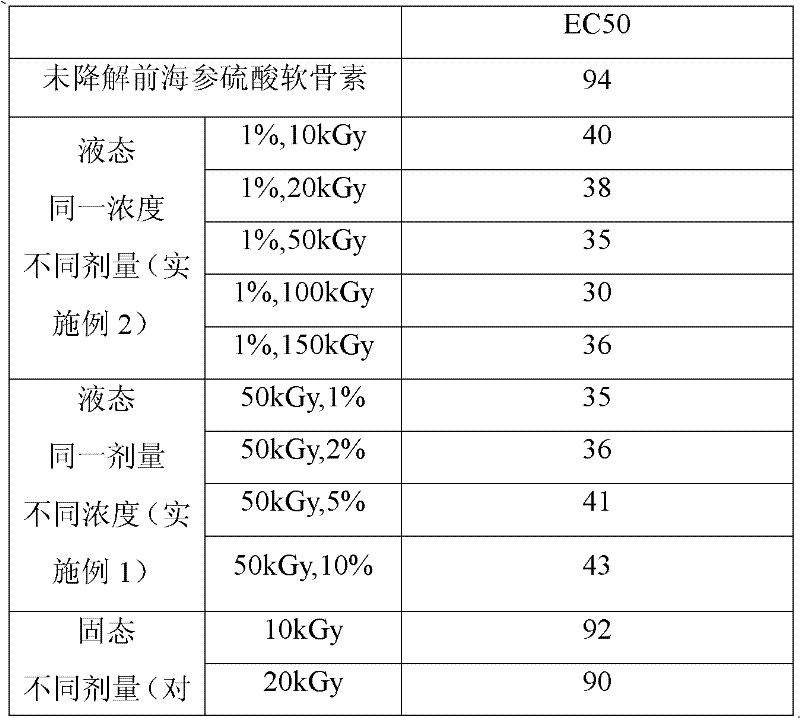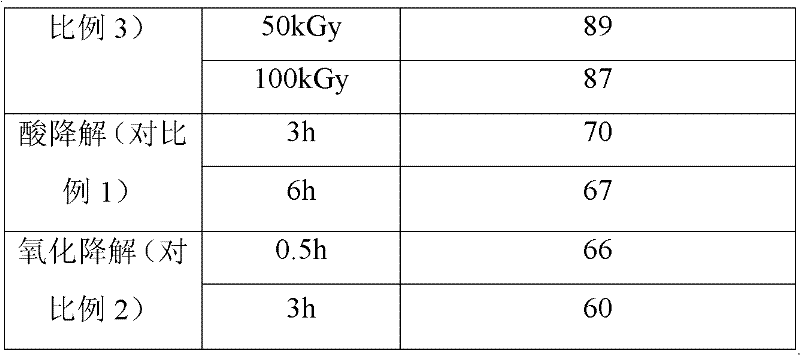Ionizing radiation degradation method for sea cucumber polysaccharide
The technology of sea cucumber polysaccharide and ionizing radiation is applied in the field of degradation method of polysaccharide compounds, which can solve the problems of detachment of sulfate group and branched-chain sulfated fucose, cumbersome operation of oxidative decomposition method, difficult process control, etc., so as to reduce the amount of products. Loss, product molecular weight uniformity, no environmental pollution effect
- Summary
- Abstract
- Description
- Claims
- Application Information
AI Technical Summary
Problems solved by technology
Method used
Image
Examples
Embodiment 1
[0022] Embodiment 1: the ionizing radiation degradation method of sea cucumber polysaccharide:
[0023] Four portions of Philippine sea cucumber chondroitin sulfate (50 mg each) were weighed and prepared into aqueous solutions respectively, and the mass percent concentrations were: 1%, 2%, 5%, and 10%. All were treated with ionizing radiation, the absorbed dose was 50kGy, and the radiation dose rate was 45kGy / min; after irradiating, stand still for 1.5 hours, the non-degradable products settled to the bottom of the container, and the supernatant was taken.
[0024] The above four supernatants were vacuum freeze-dried (-40° C.) to obtain 42 mg, 39 mg, 40 mg, and 35 mg of low-molecular-weight chondroitin sulfate (ie, low-molecular-weight oligosaccharides), respectively.
[0025] HPLC high performance gel permeation chromatography (TSK3000, 4000) was used to determine the relative molecular weight, number average molecular weight, weight average molecular weight and molecular wei...
Embodiment 2
[0029] Embodiment 2: the ionizing radiation degradation method of sea cucumber polysaccharide:
[0030] Weigh 5 parts of Philippine sea cucumber chondroitin sulfate (each part is 50 mg), and prepare an aqueous solution with a concentration of 1% by mass. Treat with 5 different doses of ionizing radiation, the absorbed doses are 10KGy, 20KGy, 50KGy, 100KGy, 150KGy, and the radiation dose rate is 45kGy / min; Serum.
[0031] The above 5 supernatants were vacuum freeze-dried (-40° C.) to obtain 39 mg, 38 mg, 42 mg, 41 mg, and 37 mg of low-molecular-weight chondroitin sulfate (ie, low-molecular-weight oligosaccharides), respectively.
[0032] The relative molecular weight of degraded chondroitin sulfate at the same concentration under different irradiation doses was determined by HPLC high performance gel permeation chromatography (TSK3000). The details are shown in Table 2.
[0033] Table 2
PUM
| Property | Measurement | Unit |
|---|---|---|
| molecular weight distribution | aaaaa | aaaaa |
Abstract
Description
Claims
Application Information
 Login to View More
Login to View More - R&D
- Intellectual Property
- Life Sciences
- Materials
- Tech Scout
- Unparalleled Data Quality
- Higher Quality Content
- 60% Fewer Hallucinations
Browse by: Latest US Patents, China's latest patents, Technical Efficacy Thesaurus, Application Domain, Technology Topic, Popular Technical Reports.
© 2025 PatSnap. All rights reserved.Legal|Privacy policy|Modern Slavery Act Transparency Statement|Sitemap|About US| Contact US: help@patsnap.com


